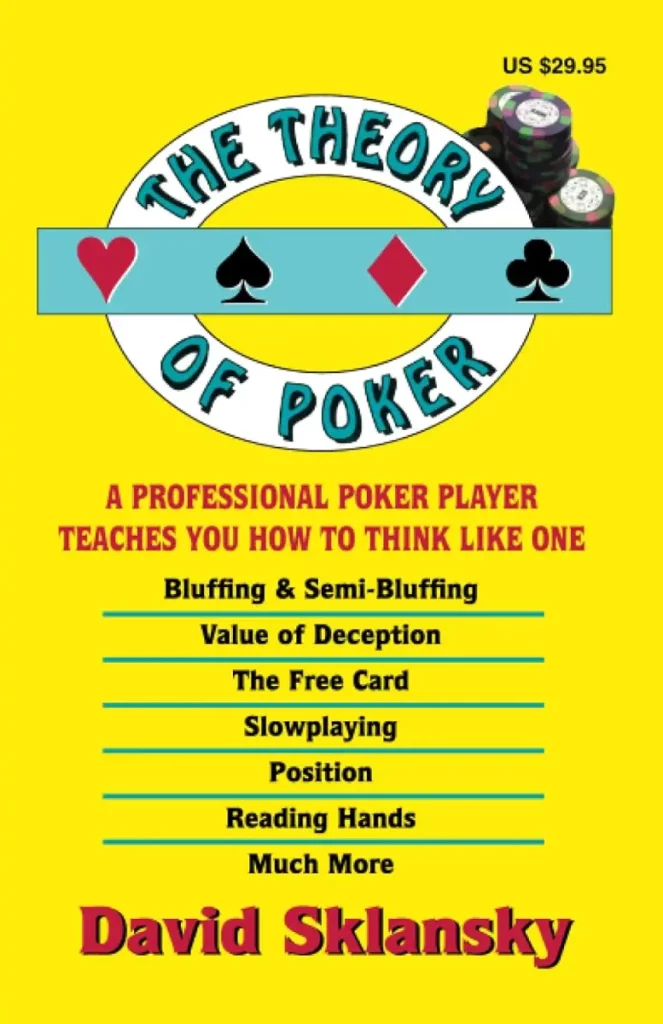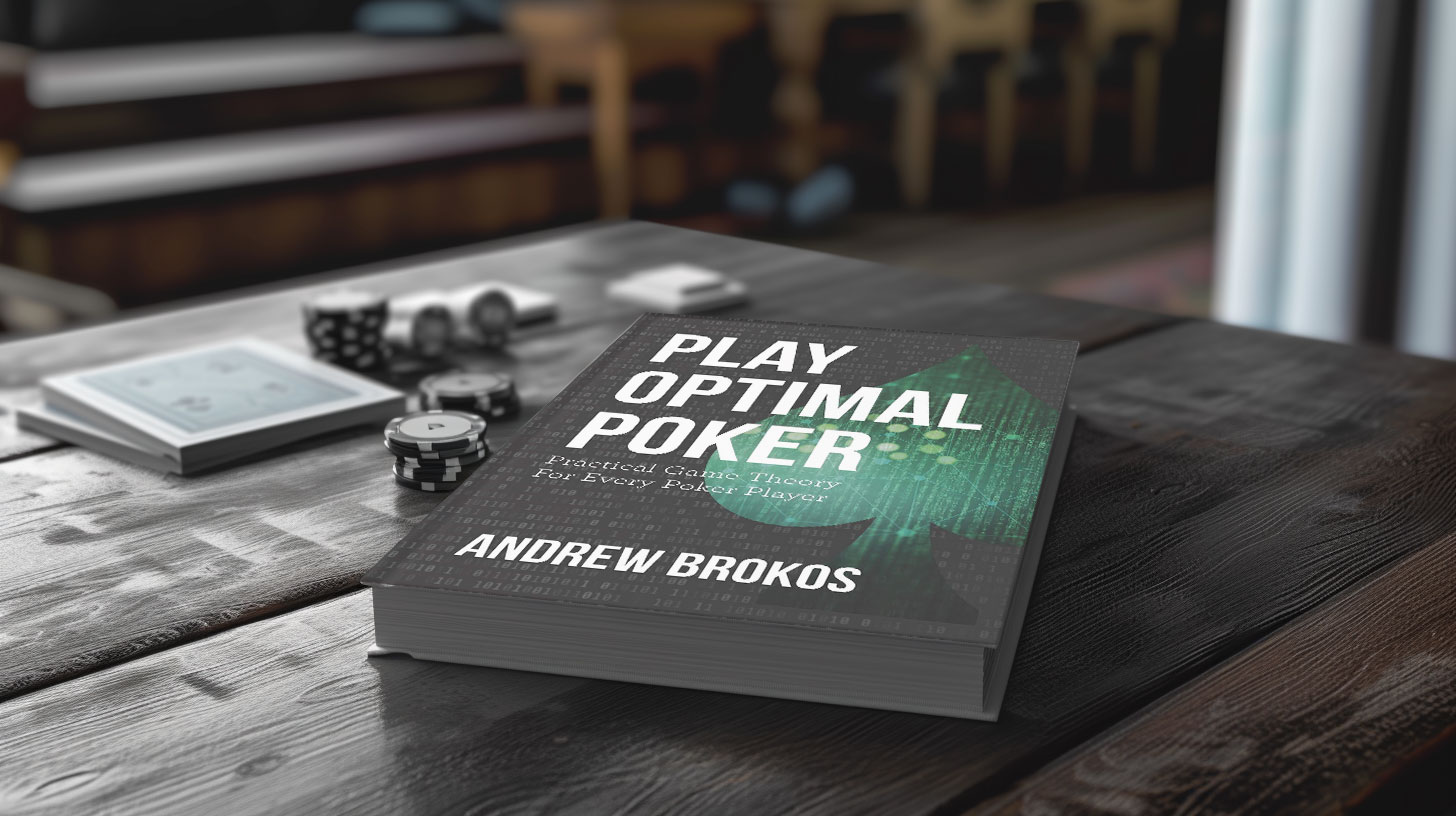
The Theory of Poker
1999, by David Sklansky.
Dive deep into the strategic world of poker with David Sklansky’s The Theory of Poker. This seminal work covers everything from fundamental principles to advanced strategies across various poker games, offering readers the tools to elevate their play and understanding of one of the most challenging and rewarding card games.
4.8
Note globale
Strategy
Application
Clarity
David Sklansky’s The Theory of Poker stands as a monumental work in the world of poker literature, offering an in-depth exploration of the game’s strategic complexities.
This book transcends the basic teachings of poker, delving into the nuanced theories that define a player’s success at the tables. Sklansky, with his unparalleled expertise, guides readers through the intricate dance of decision-making, risk assessment, and psychological warfare that defines high-stakes poker.
By marrying the mathematical rigors of probability and game theory with the human elements of bluffing and tells, The Theory of Poker provides a holistic view of poker that appeals to both the analytical mind and the intuitive player.
Through its pages, Sklansky challenges readers to elevate their understanding of poker beyond mere hand rankings and pot odds, to a more profound comprehension of the game’s underlying principles. He posits that poker is not just a game of luck but a sophisticated discipline that combines strategy, psychology, and mathematics.
This book serves as a comprehensive guide, from the fundamentals of play to the advanced strategies employed by professional players. Sklansky’s insights offer readers the tools to not only compete but to excel in the evolving landscape of poker, making The Theory of Poker an essential tome for anyone serious about mastering the art and science of this timeless game.
Pros and Cons
Synopsis of “the theory of poker”
The Theory of Poker offers an extensive exploration of poker strategy, emphasizing the game’s inherent complexities and the psychological nuances involved.
Sklansky introduces readers to advanced concepts such as the Fundamental Theorem of Poker, pot odds, expected value, and the significance of position, blending these topics with practical advice on bluffing, tells, and managing variance.
The book also delves into specific strategies for popular poker variations, including Texas Hold’em, Omaha, and Seven-Card Stud, providing readers with a comprehensive toolkit for navigating any poker scenario.
Through detailed analysis and examples, Sklansky equips players with the knowledge to make informed decisions, adapt to dynamic play, and consistently improve their overall game.

Key Points Covered in ‘The Theory of Poker’
The exploration of these key points in The Theory of Poker by David Sklansky uncovers the essence of poker strategy through a lens that combines analytical depth with practical application. Sklansky’s meticulous breakdown of complex concepts into actionable insights serves not only to educate but to transform the reader’s approach to the game.
This section, rich in strategic wisdom, equips players with the foundational theories and advanced techniques necessary for significant improvement. As readers delve into these topics, they embark on a journey of growth, where each page turns into an opportunity to refine their play and mindset towards becoming a more formidable and thoughtful poker player.
Who Is This Book For?
The Theory of Poker by David Sklansky is a treasure trove of strategic insights, designed to elevate the game of anyone who approaches the poker table with the intent to win.
Whether you’re a seasoned player or just starting out, the depth and breadth of knowledge contained within its pages cater to a wide spectrum of players.
Below, we introduce three personas that represent the book’s ideal readership, showcasing how its teachings resonate across different stages of poker proficiency.
Target Personas
Each of these personas embodies the journey of growth in poker, illustrating how The Theory of Poker serves as a critical resource at every stage of a player’s development. From foundational knowledge to advanced theory, Sklansky’s masterpiece is a guiding light for those committed to mastering the art and science of poker.
For more essential reads, check out our article on the best poker books.
4 Reasons to Buy ‘The Theory of Poker’
Foundation and Beyond
Gain not just a strong foundation in poker basics but also insights into advanced strategic concepts, setting you apart from the competition.
Expert Analysis
Benefit from Sklansky’s expert analysis, drawing from his extensive experience and success in the poker world, distilled into digestible strategies.
Game Theory Application
Understand how game theory applies to poker, offering you a significant edge in making mathematically sound decisions under pressure.
Versatile Strategies
Learn strategies that apply across various poker games, ensuring you’re well-equipped no matter the format or variation you encounter.
My Honest Opinion
David Sklansky’s The Theory of Poker remains a cornerstone in poker literature for its comprehensive approach to the game’s strategic elements.
The book’s insights into the mathematical and psychological aspects of poker make it an invaluable resource for anyone serious about improving their game.
While the depth of theory might seem daunting to beginners, the practical examples and clear explanations make the concepts accessible to players at all levels. The Theory of Poker is not just a book; it’s an investment in mastering the game of poker.

about dAVID sKLANSKY
David Sklansky is a professional poker player and acclaimed author, known for his expertise in gambling theory and practice. With multiple World Series of Poker bracelets to his name, Sklansky has contributed significantly to the field of poker strategy through his writings.
His analytical approach and ability to break down complex concepts into understandable terms have made his books, especially The Theory of Poker, must-reads for anyone serious about the game.

